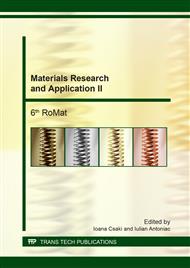[1]
H. Rosch, H.J. Schwarz, Damage to frescoes caused by sulphate bearing salts: Where does the sulphur come from?, Studies in Conservation. 38 (1993), 224-230.
DOI: 10.2307/1506367
Google Scholar
[2]
J. Ashurst, F.G. Dimes, Conservation of Building and Decorative Stone. Vols. I, II. Butterworth, London, (1990).
Google Scholar
[3]
M. Matteini, A. Moles, S. Giovannoni, Calcium oxalate as a protective mineral system for wall paintings: Methodology and analyses. In: Fassina, V., Ott, H. & Zezza, F. (eds. ) The Conservation of Monuments in the Mediterranean Basin. Proc. 3rd Intern. Symp., Venice 1994, (1994).
Google Scholar
[4]
L. Lazzarini, O. Salvadori, A reassessment of the formation of the patina called Scialbatura, Studies in Conservation. 34 (1989), 20 -26.
DOI: 10.2307/1506157
Google Scholar
[5]
H. Rosch, H.J. Schwarz, Damage to frescoes caused by sulphate bearing salts: Where does the sulphur come from?, Studies in Conservation. 38 (1993), 224-230.
DOI: 10.2307/1506367
Google Scholar
[6]
M. Matteini, An assessment of Florentine methods of wall painting conservation based on the use of mineral treatments, in: Cather, S. (ed. ) The Conservation of Wall Paintings. Proceedings of a Symposium Organized by the Courtauld Institute of Art and the Getty Conservation Institute, J. Paul Getty Trust, London, (1987).
DOI: 10.1093/ww/9780199540884.013.45080
Google Scholar
[7]
W. Quellmalz, The calcium oxalate Whewellite: mineralogy and natural occurrences, in: International Symposium Proceedings on the Oxalate Films: Origin and Significance in the Conservation of Works of Art. Milano, (1989), 103-112.
Google Scholar
[8]
B.B. Tomazic, G.H. Nancollas, Crystal growth of calcium oxalate hydrates. Acomparative kinetics study, J. Colloid Interface Sci. 75 (1980), 149–160.
DOI: 10.1016/0021-9797(80)90358-6
Google Scholar
[9]
M. Del Monte, C. Sabbioni, A study of the patina called Scialbaturta onImperial Roman marbles, Stud. Conserv. 32 (1987), 114–121.
DOI: 10.1179/sic.1987.32.3.114
Google Scholar
[10]
B. Doherty, M. Pamplona, R. Selvaggi, C. Miliani, M. Matteini, A. Sgamellotti, B. Brunetti, Efficiency and resistance of the artificial oxalate protectiontreatment on marble against chemical weathering, Appl. Surf. Sci. 253 (2007), 4477–4484.
DOI: 10.1016/j.apsusc.2006.09.056
Google Scholar
[11]
T. Dreyfuss, J.A. Cassar The performance of calcium oxalate induced year on globigerina limestone surface, 12th Intern. Congr. Deterior. Conserv. Stone Columbia University, NY, (2012).
Google Scholar
[12]
C. Conti, I. Aliatis, M. Casati, C. Colombo, M. Matteini, R. Negrotti, M. Realini, G. Zerbi, Diethyl oxalate as a potential new product for conservation decayed carbonate substrates, J. Cult. Herit. 15 (3) (2014), 336-338.
DOI: 10.1016/j.culher.2013.08.002
Google Scholar
[13]
K. Manjula, K. Pazhanichamy, S. Kumaran, T. Eevera, C. Dale Keefe And K. Rajendran, Growth Characterization Of Calcium Oxalate Monohydrate Crystals Influenced By Costus Igneus Aqueous Stem Extract, International Journal of Pharmacy and Pharmaceutical Sciences. 4 (1) (2012).
DOI: 10.1007/s00240-012-0462-6
Google Scholar
[14]
R.L. Frost, J. Yang, and Z. Ding. Raman and FTIR spectroscopy of natural oxalates: Implications for the evidence of life on Mars. Chinese Science Bulletin, 48(17) (2003), 1844-1852.
DOI: 10.1007/bf03184066
Google Scholar
[15]
R.M., Ion, D. Turcanu-Caruţiu, R.C. Fierăscu, I. Fierăscu, I.R. Bunghez, M.L. Ion, S. Teodorescu, G. Vasilievici, V. Rădiţoiu, Caoxite-hydroxyapatite composition as consolidating material for the chalk stone from Basarabi–Murfatlar churches ensemble, Appl. Surf. Sci. 358, Part B (2015).
DOI: 10.1016/j.apsusc.2015.08.196
Google Scholar
[16]
J.M. Teutonico, A Laboratory Manual for Architectural Conservators. Rome: ICCROM, (1988).
Google Scholar


